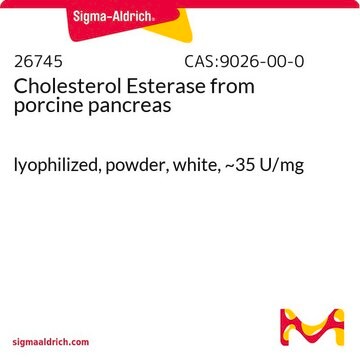N3129
4-Nitrophenyl phosphate bis(cyclohexylammonium) salt
phosphatase substrate, chromogenic, ≥97% anhydrous basis, powder
Synonim(y):
p-Nitrophenyl phosphate bis(cyclohexylammonium) salt, PNPP
About This Item
Polecane produkty
product name
4-Nitrophenyl phosphate bis(cyclohexylammonium) salt, phosphatase substrate
Próba
≥97% anhydrous basis
Postać
powder
rozpuszczalność
water: 10 mg/mL, clear, colorless to faintly yellow
temp. przechowywania
−20°C
ciąg SMILES
NC1CCCCC1.NC2CCCCC2.OP(O)(=O)Oc3ccc(cc3)[N+]([O-])=O
InChI
1S/C6H6NO6P.2C6H13N/c8-7(9)5-1-3-6(4-2-5)13-14(10,11)12;2*7-6-4-2-1-3-5-6/h1-4H,(H2,10,11,12);2*6H,1-5,7H2
Klucz InChI
KXNNUYCXODNFBD-UHFFFAOYSA-N
Szukasz podobnych produktów? Odwiedź Przewodnik dotyczący porównywania produktów
Powiązane kategorie
Zastosowanie
Działania biochem./fizjol.
Kod klasy składowania
11 - Combustible Solids
Klasa zagrożenia wodnego (WGK)
WGK 3
Temperatura zapłonu (°F)
Not applicable
Temperatura zapłonu (°C)
Not applicable
Środki ochrony indywidualnej
Eyeshields, Gloves, type N95 (US)
Certyfikaty analizy (CoA)
Poszukaj Certyfikaty analizy (CoA), wpisując numer partii/serii produktów. Numery serii i partii można znaleźć na etykiecie produktu po słowach „seria” lub „partia”.
Masz już ten produkt?
Dokumenty związane z niedawno zakupionymi produktami zostały zamieszczone w Bibliotece dokumentów.
Klienci oglądali również te produkty
Produkty
NBT-BCIP substrate system aids in western blotting and immunohistological staining, producing a blue-purple insoluble end product.
Nasz zespół naukowców ma doświadczenie we wszystkich obszarach badań, w tym w naukach przyrodniczych, materiałoznawstwie, syntezie chemicznej, chromatografii, analityce i wielu innych dziedzinach.
Skontaktuj się z zespołem ds. pomocy technicznej













